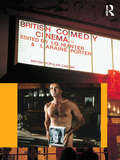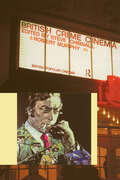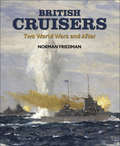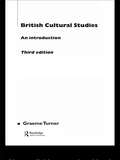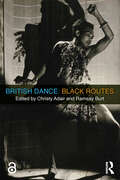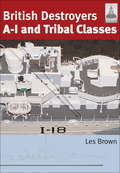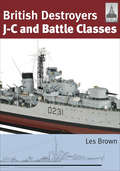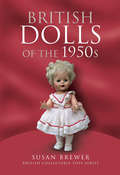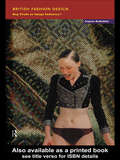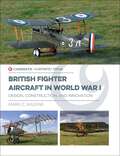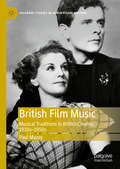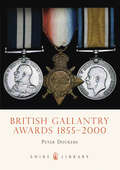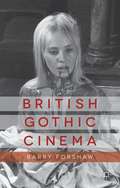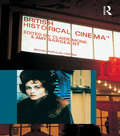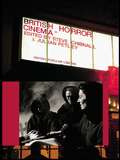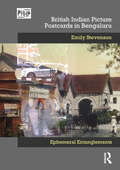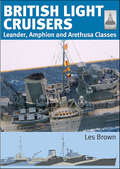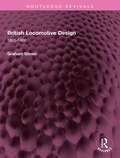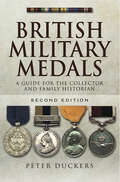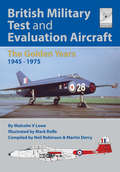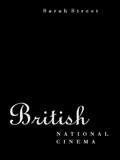- Table View
- List View
British Comedy Cinema (British Popular Cinema)
by Laraine Porter I. Q. HunterBritish comedy cinema has been a mainstay of domestic production since the beginning of the last Century and arguably the most popular and important genre in British film history. This edited volume will offer the first comprehensive account of the rich and popular history of British comedy cinema from silent slapstick and satire to contemporary romantic comedy. Using a loosely chronological approach, essays cover successive decades of the 20th and 21st Century with a combination of case studies on key personalities, production cycles and studio output along with fresh approaches to issues of class and gender representation. It will present new research on familiar comedy cycles such as the Ealing Comedies and Carry On films as well as the largely undocumented silent period along with the rise of television spin offs from the 1970s and the development of animated comedy from 1915 to the present. Films covered include: St Trinians, A Fish Called Wanda, Brassed Off, Local Hero, The Full Monty, Four Lions and In the Loop. Contributors: Melanie Bell, Alan Burton, James Chapman, Richard Dacre, Ian Hunter, James Leggott, Sharon Lockyer, Andy Medhurst, Lawrence Napper, Tim O’Sullivan, Laraine Porter, Justin Smith, Sarah Street, Peter Waymark, Paul Wells
British Costume from Earliest Times to 1820
by Charles AshdownHard-to-find classic drew on primary sources — actual costumes, illuminated manuscripts, effigies, etc. — to provide authentic detailed coverage of what people wore in Britain from the early Saxon period (ca. A.D. 460) to the reign of King George III (1820). Clothing of commoners, royalty, and ecclesiastics. Indispensable for fashion historians.
British Crime Cinema (British Popular Cinema)
by Robert Murphy Steve ChibnallThis is the first substantial study of British cinema's most neglected genre. Bringing together original work from some of the leading writers on British popular film, this book includes interviews with key directors Mike Hodges (Get Carter) and Donald Cammel (Performance). It discusses an abundance of films including:* acclaimed recent crime films such as Shallow Grave, Shopping, and Face.* early classics like They Made Me A Fugitive* acknowledged classics such as Brighton Rock and The Long Good Friday* 50s seminal works including The Lavender Hill Mob and The Ladykillers.
British Cruisers: Two World Wars and After
by Norman Friedman&“An extraordinarily detailed account of the development of Royal Navy cruisers . . . a towering work&” from the author of Fighting the Great War at Sea (Warship 2012). For most of the twentieth century, Britain possessed both the world&’s largest merchant fleet and its most extensive overseas territories. It is not surprising, therefore, that the Royal Navy always showed a particular interest in the cruiser—a multipurpose warship needed in large numbers to defend trade routes and police the empire. Above all other types, the cruiser&’s competing demands of quality and quantity placed a heavy burden on designers, and for most of the interwar period, Britain sought to square this circle through international treaties restricting both size and numbers. In the process, she virtually invented the heavy cruiser and inspired the large 6in-armed cruiser, neither of which, ironically, served her best interests. This book seeks to comprehend, for the first time, the full policy background—from which a different and entirely original picture of British cruiser development emerges. After the war, the cruiser&’s role was reconsidered, and the final chapters of the book cover modernizations, the plans for missile-armed ships, and the convoluted process that turned the &“through-deck cruiser&” into the Invincible class light carriers. With detailed appendices of ship data, and illustrated in depth with photos and A.D. Baker&’s specially commissioned plans, British Cruisers truly matches the lofty standards set by Friedman&’s previous books on British destroyers. &“Wow! . . . Lavishly illustrated with a photograph or line plan on almost every page. The text is packed with technical information, detail, and description of design, construction and application of these important ships.&” —Clash of Steel
British Cultural Studies (Media And Popular Culture Ser. #Vol. 7)
by Graeme Turneris a comprehensive introduction to the British tradition of cultural studies. Turner offers an accessible overview of the central themes that have informed British cultural studies: language, semiotics, Marxism and ideology, individualism, subjectivity and discourse. Beginning with a history of cultural studies, Turner discusses the work of such pioneers as Raymond Williams, Richard Hoggart, E. P.Thompson, Stuart Hall and the Birmingham Centre for Contemporary Cultural Studies. He then explores the central theorists and categories of British cultural studies: texts and contexts; audience; everyday life; ideology; politics, gender and race.The third edition of this successful text has been fully revised and updated to include:* How to apply the principles of cultural studies and how to read a text* An overview of recent ethnographic studies* Discussion of anthropological theories of consumption* Questions of identity and new ethnicities* How to do cultural studies, and an evaluation of recent research methodologies* A fully updated and comprehensive bibliography
British Dance: Black Routes
by Christy Adair Ramsay BurtBritish Dance, Black Routes is an outstanding collection of writings which re-reads the achievements of Black British dance artists, and places them within a broad historical, cultural and artistic context. Until now discussion of choreography by Black dance practitioners has been dominated by the work of African-American artists, facilitated by the civil rights movement. But the work produced by Black British artists has in part been within the context of Britain’s colonial legacy. Ramsay Burt and Christy Adair bring together an array of leading scholars and practitioners to review the singularity and distinctiveness of the work of British-based dancers who are Black and its relation to the specificity of Black British experiences. From sub-Saharan West African and Caribbean dance forms to jazz and hip-hop, British Dance, Black Routes looks afresh at over five decades of artistic production to provide an unparalleled resource for dance students and scholars. Appendix 2 of this book is freely available as a downloadable Open Access PDF at http://www.taylorfrancis.com under a Creative Commons Attribution-Non Commercial-No Derivatives (CC-BY-NC-ND) 4.0 license.
British Dance: Black Routes
by Ramsay BurtBritish Dance, Black Routes is an outstanding collection of writings which re-reads the achievements of Black British dance artists, and places them within a broad historical, cultural and artistic context.Until now discussion of choreography by Black dance practitioners has been dominated by the work of African-American artists, facilitated by the civil rights movement. But the work produced by Black British artists has in part been within the context of Britain’s colonial legacy.Ramsay Burt and Christy Adair bring together an array of leading scholars and practitioners to review the singularity and distinctiveness of the work of British-based dancers who are Black and its relation to the specificity of Black British experiences.From sub-Saharan West African and Caribbean dance forms to jazz and hip-hop, British Dance, Black Routes looks afresh at over five decades of artistic production to provide an unparalleled resource for dance students and scholars.Appendix 2 of this book is freely available as a downloadable Open Access PDF at http://www.taylorfrancis.com under a Creative Commons Attribution-Non Commercial-No Derivatives (CC-BY-NC-ND) 4.0 license.
British Destroyers A-I and Tribal Classes: A-i And Tribal Classes (Shipcraft Ser. #Vol. 11)
by Les BrownThe 'ShipCraft' series provides in-depth information about building and modifying model kits of famous warship types. Lavishly illustrated, each book takes the modeller through a brief history of the subject class, then moves to an extensive photographic survey of either a high-quality model or a surviving example of the ship. Hints on building the model, and on modifying and improving the basic kit, are followed by a section on paint schemes and camouflage, featuring numerous colour profiles and highly-detailed line drawings. The strengths and weaknesses of available kits of the ships are reviewed, and the book concludes with a section on research references—books, monographs, large-scale plans and relevant websites.This new volume deals with the classes which represent the whole inter-war development of British destroyers, from the prototypes Amazon and Ambuscade of 1926—the first new post World War I design—to the powerful and radically different 'Tribal' class a decade later. These ships formed the backbone of Royal Navy destroyer flotillas in the Second World War.
British Destroyers: J-c And Battle Classes (Shipcraft Ser. #21)
by Les Brown&“A terrific author . . . invaluable to the modeler wishing to reproduce these classes of destroyers, and also to those interested in naval history.&”—IPMS Magazine The ShipCraft series provides in-depth information about building and modifying model kits of famous warship types. Lavishly illustrated, each book takes the modeler through a brief history of the subject class, highlighting differences between sisterships and changes in their appearance over their careers. This includes paint schemes and camouflage, featuring color profiles and highly detailed line drawings and scale plans. The modeling section reviews the strengths and weaknesses of available kits, lists commercial accessory sets for super-detailing of the ships, and provides hints on modifying and improving the basic kit. This is followed by an extensive photographic survey of selected high-quality models in a variety of scales, and the book concludes with a section on research references—books, monographs, large-scale plans and relevant websites. A follow-up to ShipCraft 11 on inter-war destroyers, this new volume deals with the later classes which were the most modern British destroyers of the Second World War. Marked by a common single-funneled silhouette, they were actually very varied, ranging from the large and powerful J to N flotillas, via the austere &“War Emergency&” classes that were built in large numbers, to the radically different &“Battle&” class, designed with a powerful AA armament for service in the Pacific. &“This book will be of interest to those who want an easy reference book that covers the British and Australian destroyers of this period, especially with regard to camouflage and overall appearance in service.&”—Australian Naval Institute
British Dolls of the 1950s
by Susan BrewerPhotos, descriptions, and fascinating history for dedicated doll collectors. In the 1950s, a new material—plastic—revolutionized the doll trade and made dolls affordable for people of all classes. This book focuses specifically on British dolls of that decade, offering not only useful information for collectors but a glimpse into the history and culture that surrounded these cherished toys. Along with photos and descriptions, this unique guide covers: doll manufacturersmust-buy dollswhat to spot when buying dollshow to avoid buying fakesa where-to-buy directorydoll hospitalsspecialist museums
British Drama of the Industrial Revolution
by Frederick BurwickBetween the advent of the French Revolution and the short-lived success of the Chartist Movement, overworked and underpaid labourers struggled to achieve solidarity and collective bargaining. That history has been told in numerous accounts of the age, but never before has it been told in terms of the theatre of the period. To understand the play lists of a theatre, it is crucial to examine the community which that theatre serves. In the labouring-class communities of London and the provinces, the performances were adapted to suit the local audiences, whether weavers, or miners, or field workers. Examining the conditions and characteristics of representative provincial theatres from the 1790s to 1830s, Frederick Burwick argues that the meaning of a play changes with every change in the performance location. As contributing factors in that change, Burwick attends to local political and cultural circumstances as well as to theatrical activities and developments elsewhere.
British Fashion Design: Rag Trade or Image Industry?
by Angela McRobbieBritish Fashion Design explores the tensions between fashion as art form, and the demands of a ruthlessly commercial industry. Based on interviews and research conducted over a number of years, Angela McRobbie charts the flow of art school fashion graduates into the industry; their attempts to reconcile training with practice, and their precarious position between the twin supports of the education system and the commercial sector. Stressing the social context of cultural production, McRobbie focuses on British fashion and its graduate designers as products of youth street culture, and analyses how designers from diverse backgrounds have created a labour market for themselves, remodelling `enterprise culture` to suit their own careers.
British Fighter Aircraft in World War I: Design, Construction, and Innovation (Casemate Illustrated Special)
by Mark C. WilkinsA vivid pictorial history: &“Buy this book right now. It is rare that ISD gives an instant five-star rating to any new volume, but [this] is a rare book.&” —Indy Squadron Dispatch World War I witnessed unprecedented growth and innovation in aircraft design, construction, and—as the war progressed—mass production. Each country generated its own innovations, sometimes in surprising ways—Albatros Fokker, Pfalz, and Junkers in Germany and Nieuport, Spad, Sopwith, and Bristol in France and Britain. This book focuses on the British approach to fighter design, construction, and mass production. Initially the French led the way in Allied fighter development with their Bleriot trainers, then nimble Nieuport Scouts—culminating with the powerful, fast gun platforms as exemplified by the Spads. The Spads had a major drawback however, in that they were difficult and counterintuitive to fix in the field. The British developed fighters in a very different way; Tommy Sopwith had a distinctive approach to fighter design that relied on lightly loaded wings and simple functional box-girder fuselages. His Camel was revolutionary as it combined all the weight well forward, enabling the Camel to turn very quickly—but also making it an unforgiving fighter for the inexperienced. The Royal Aircraft Factory&’s SE5a represented another leap forward with its comfortable cockpit, modern instrumentation, and inline engine—clearly influenced by both Spads and German aircraft. Each manufacturer and design team vied for the upper hand and deftly and quickly appropriated good ideas from other companies—be they friend or foe. Developments in tactics and deployment also influenced design—from the early reconnaissance planes, to turn fighters, and finally planes that relied upon formation tactics, speed, and firepower. This book tells their story through extensive photos and accompanying text. &“Handy not only as an aircraft model reference, but also as great reading for all history fans.&” —DetailScaleView &“Sidebars add important information at the proper place.&” —Air Power History
British Film Music: Musical Traditions in British Cinema, 1930s–1950s (Palgrave Studies in Audio-Visual Culture)
by Paul MazeyThis book offers a fresh approach to British film music by tracing the influence of Britain’s musical heritage on the film scores of this era. From the celebration of landscape and community encompassed by pastoral music and folk song, and the connection of both with the English Musical Renaissance, to the mystical strains of choral sonorities and the stirring effects of the march, this study explores the significance of music in British film culture. With detailed analyses of the work of such key filmmakers as Michael Powell and Emeric Pressburger, Laurence Olivier and Carol Reed, and composers including Ralph Vaughan Williams, William Walton and Brian Easdale, this systematic and in-depth study explores the connotations these musical styles impart to the films and considers how each marks them with a particularly British inflection.
British Gallantry Awards 1855-2000
by Peter DuckersThis book surveys the British decorations and medals from the origins in the Crimean War of 1854-6 up to the end of the twentieth century.
British Gothic Cinema
by Barry ForshawFrom the films produced by the Hammer studios and their rivals in the 1940s and 1950s, to the films of the 21st century and their current popularity, Forshaw provides a definitive, wide-ranging study of British horror cinema. Beginning with a lively discussion of the great literary antecedents, British Gothic Cinema discusses the flowering of the genre in the middle of the 20th century and the headline-grabbing critical and establishment revulsion over the unprecedented levels of violence and sexuality. It also explores the rude health of the field and its continuing influence. With enthusiasm and scholarship, Forshaw celebrates the British cinema's long love affair with the Gothic and the macabre, both persevering characteristics of modern film and television.
British Historical Cinema (British Popular Cinema)
by Claire Monk Amy SargeantFilms recreating or addressing 'the past' - recent or distant, actual or imagined - have been a mainstay of British cinema since the silent era. From Elizabeth to Carry On Up The Khyber, and from the heritage-film debate to issues of authenticity and questions of genre, British Historical Cinema explores the ways in which British films have represented the past on screen, the issues they raise and the debates they have provoked. Discussing films from biopics to literary adaptations, and from depictions of Britain's colonial past to the re-imagining of recent decades in retro films such as Velvet Goldmine, a range of contributors ask whose history is being represented, from whose perspective, and why.
British Horror Cinema (British Popular Cinema)
by Julian Petley Steve ChibnallBritish Horror Cinema investigates a wealth of horror filmmaking in Britain, from early chillers like The Ghoul and Dark Eyes of London to acknowledged classics such as Peeping Tom and The Wicker Man. Contributors explore the contexts in which British horror films have been censored and classified, judged by their critics and consumed by their fans. Uncovering neglected modern classics like Deathline, and addressing issues such as the representation of family and women, they consider the Britishness of British horror and examine sub-genres such as the psycho-thriller and witchcraftmovies, the work of the Amicus studio, and key filmmakers including Peter Walker. Chapters include: the 'Psycho Thriller' the British censors and horror cinema femininity and horror film fandom witchcraft and the occult in British horror Horrific films and 1930s British Cinema Peter Walker and Gothic revisionism. Also featuring a comprehensive filmography and interviews with key directors Clive Barker and Doug Bradley, this is one resource film studies students should not be without.
British Indian Picture Postcards in Bengaluru: Ephemeral Entanglements (Photography, History: History, Photography)
by Emily StevensonCombining ethnographic and archival research, this book examines the lives of colonial-period postcards and reveals how they become objects of contemporary historical imagination in India. Picture postcards were circulated around the world in their billions in the early twentieth century and remained, until the advent of social media, unmatched as the primary means of sharing images alongside personal messages. This book, based on original research in Bengaluru, shows that their lives stretch from their initial production and consumption in the early 1900s into the present where they act as visual and material mediators in postcolonial productions of history, locality, and heritage against a backdrop of intense urban change. The book will be of interest to photographic historians, visual anthropologists, and art historians.
British Light Cruisers: Leander, Amphion and Arethusa Classes (ShipCraft)
by Les BrownThe ‘ShipCraft’ series provides in-depth information about building and modifying model kits of famous warship types. Lavishly illustrated, each book takes the modeler through a brief history of the subject, highlighting differences between ships and changes in their appearance over their careers. This includes paint schemes and camouflage, featuring color profiles and highly detailed line drawings and scale plans. The modeling section reviews the strengths and weaknesses of available kits, lists commercial accessory sets for super-detailing of the subjects, and provides hints on modifying and improving the basic kit. This is followed by an extensive photographic gallery of selected high-quality models in a variety of scales, and the book concludes with a section on research references – books, monographs, large-scale plans and relevant websites. This is the first of two volumes covering Royal Navy 6-inch cruisers of the 1930s and later, this one devoted to three related designs armed with twin mountings. This group includes some of the most celebrated ships of the Second World War, like Ajax, Achilles, Penelope and the Australian Sydney. The next volume will feature the later classes armed with the triple 6-inch mounting – the ‘Towns’, ‘Colonies’ and their derivatives. With its unparalleled level of visual information – paint schemes, models, line drawings and photographs – this book is simply the best reference for any modelmaker setting out to build one of these famous cruisers.
British Literature For Christian Schools
by Ronald Arthur HortonTraces the development of English literature from the early Middle Ages to the early twentieth century including examples of poems, essays, plays, short stories, and religious writings.
British Locomotive Design: 1825-1960 (Routledge Revivals)
by Graham GloverFirst published in 1967, British Locomotive Design is a review of British locomotive practice during the century and a quarter of steam’s ascendency. The author shows how the Stephenson basic plan, while remaining essentially unchanged, was adapted over the years to meet the increasing demands made upon it in terms of haulage power and speed. The subject’s widespread appeal is derived largely from the enormous variety of practical examples furnished by the products of the former companies, the groups and nationalisation, and, in the description of these by one who has a lifelong predilection for the steam engine in all its manifestations, readers will find due recognition accorded to the machines which had won their favour and, with others, have exercised a fascination as unquestionable as it is difficult to account for in set terms. This book will be of interest to students of engineering, technology, design and history.
British Military Medals: A Guide for the Collector and Family Historian Second Edition
by Peter DuckersFully revised second edition of Peter Duckers best-selling guide to military medals.This second edition of Peter Duckers best-selling British Military Medals traces the history of medals and gallantry awards from Elizabethan times to the modern day, and it features an expert account of their design and production. Campaign and gallantry medals are a key to understanding - and exploring - British and imperial military history, and to uncovering the careers and exploits of individual soldiers. In a series of succinct and well-organized chapters he explains how medals originated, to whom they were awarded and how the practice of giving medals has developed over the centuries. His work is a guide for collectors and for local and family historians who want to learn how to use medals to discover the history of military units and the experiences of individuals who served in them.
British Military Test and Evaluation Aircraft: The Golden Years 1945–1975 (Flightcraft Ser. #18)
by Malcolm V. Lowe&“An attractive book . . . chock full with photos and drawings of all the planes that have been drawn and built in these years in the UK.&” —AviationBookReviews.com It could be argued that the heyday of British military aircraft flight testing began in the 1940s, and continued throughout the three decades that followed, during the so-called Cold War period. As such, the authors have purposely chosen to focus on the first 30 years, The Golden Years, 1945 to 1975, from the end of World War Two until the mid-1970s. This was arguably the most exciting period with many wonderful and new types rubbing shoulders with wartime and immediate postwar designs that were utilized for development purposes, making for an eclectic mix of shapes and color schemes. Alongside the technical aspects of military testing and development, are the many and varied color schemes and markings carried by the aircraft themselves—not only by the brand-new experimental designs, but by existing production machines, suitably modified, to greater or lesser degrees, to develop the technical advances in systems and weaponry. Scores of different aircraft types are covered in British Military Test and Evaluation Aircraft: The Golden Years 1945-1975, with over 65 rarely seen contemporary photographs from private collections, and, differing slightly from previous Flight Craft book formats, over 50 pages of specially commissioned full color profiles and plan views, visually chronicling the diverse range of color schemes and markings applied to these fascinating airplanes. &“The development of British military aircraft is examined in extraordinary and fascinating detail in Malcolm Lowe&’s spectacular book.&” —Books Monthly
British National Cinema
by Sarah StreetThe first substantial overview of the British film industry with emphasis on its genres, stars, and socioeconomic context, British National Cinema by Sarah Street is an important title in Routledge's new National Cinemas series. British National Cinema synthesizes years of scholarship on British film while incorporating the author' fresh perspective and research. Street divides the study of British cinema into four sections: the relation between the film industry and government; specific film genres; movie stars; and experimental cinema. In addition, this beautifully illustrated volume includes over thirty stills from every sphere of British cinema. British National Cinema will be of great interest to film students and theorists as well as the general reader interested in the fascinating scope of British film.
